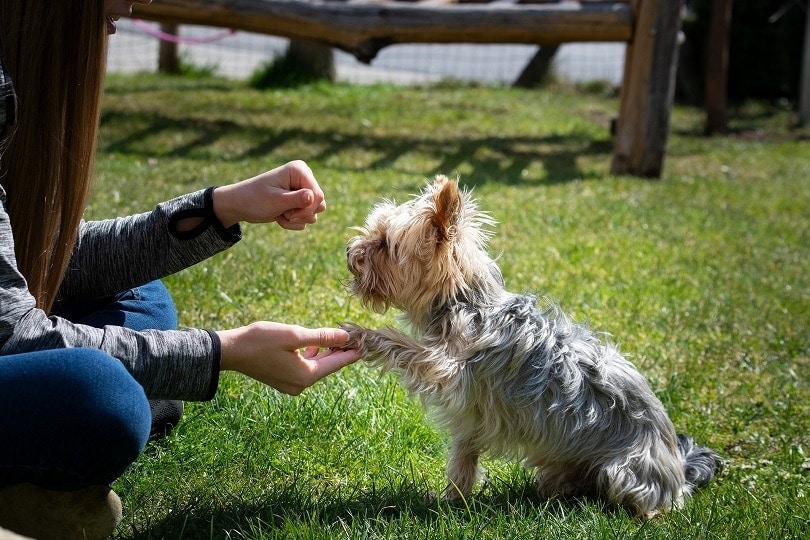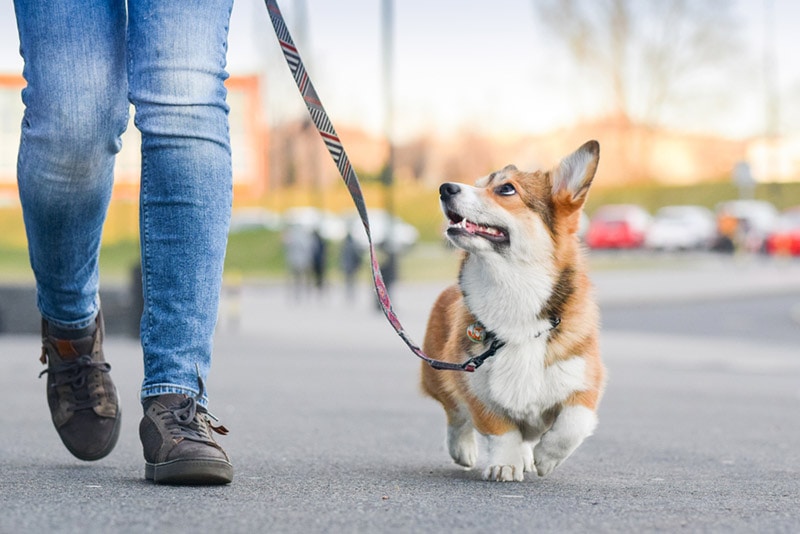How to Stop Your Dog from Barking at a Cat in 7 Steps

Updated on

When something scares or excites a dog, sometimes their barks only make things worse. It’s very common for dogs to bark at cats, but that doesn’t mean it’s desirable behavior. Luckily, you can resolve most dog behavior issues with obedience training and exposure to new experiences, including cats.
Whether you plan to have a multi-species household or want your daily walks to go more smoothly, some training can go a long way. Here are seven stages to help your dog be comfortable around cats.

The 7 Steps to Stop Your Dog From Barking at a Cat
If you plan to introduce a new dog or cat into your household, some preparation before bringing the new pet in will help make the transition much smoother. If the cat is going to be the new pet, start training your dog a few weeks or months before, if possible, and bring in your cat’s toys and equipment first. Whether you’re adding a cat or a dog, make sure you have spaces set aside for each pet to have personal space as needed—perhaps a spare bedroom or a bathroom.
1. Teach Your Dog His First Commands
The first step of training your dog to behave when needed is to teach him some basic commands if you haven’t already. Start in a quiet environment without distractions and teach your dog via positive reinforcement. Set aside time to practice daily, and practice with your dog throughout the day. Give your dog treats and praise as he follows commands until he associates the command word or gesture with the action.
Good commands to start with are “heel” and “sit” because these commands are fairly easy to teach. They are also good commands because although they don’t stop barking completely, they do keep your dog from chasing or jumping on others.

2. Practice Obedience in Distracting Environments
Once your dog has mastered a basic command at home, make sure to practice in distracting environments before your dog meets cats. This might include going on a walk at a busy park or inviting exciting guests to your home.
3. Introduce Your Dog to Cat Scents and Sounds
Along with teaching your dog obedience, you also want to normalize cats to your dog so they aren’t unfamiliar or exciting. Introduce your dog to a cat’s blanket to familiarize your dog with the scent of cats. Let him explore the scent, but also don’t be afraid to practice obedience commands if he gets too excited.
If you plan on introducing a new pet to your home, start by keeping the new pet in a separate space for the first several days. Occasionally switch roles, putting the old pet in a safe space while the new pet explores the home. This lets your pets get used to each other’s scents without a face-to-face encounter.

4. Make Early Meetings Count
Once your dog no longer barks at the sound or smell of your cat and both pets are comfortable, you might feel ready to let your pets meet. This meeting is important because it will give your pets first impressions of each other, but if it goes poorly, it’s not insurmountable. Keep your dog on a leash for this meeting. Ideally, have a second person available to shepherd your cat.
You can use an obedience command to distract your dog initially. Shower both pets with plenty of praise and attention and end the meeting if one pet or the other starts to growl, bark, or hiss. Initial meetings should be no more than ten minutes.
If you want to teach your dog better manners in general but don’t have a pet cat, it might not be helpful to let your dog meet a cat up close. Instead, start practicing good behavior when you encounter a cat outside. Give your dog commands to focus on and distract him with attention or toys.
5. Ease Into Unsupervised Visits if Wanted
At first, visits between new pets should be supervised and short, but over the first few weeks of having pets, you should move towards longer and less closely choreographed visits. Don’t move into a new type of visit unless your pets are doing well, and always remove a pet who becomes aggressive. Although it will take time, eventually your dog and cat will be able to spend time together without you needing to worry about them fighting.

6. Teach “Speak” and “Quiet” If Needed
Many dogs will learn good behavior without needing a specific command to stop barking, but some dogs benefit from a quiet command. If you feel like your dog will benefit from this, start by teaching your dog to associate barking with a command like “speak” first. Once your dog gets this down, you can alternate between a “speak” and “quiet” command or similar phrases to teach your dog how to stop barking when needed.
Last Thoughts
As you can see, it’s a lot harder to have a well-behaved dog than a badly-behaved one! But putting in the work to help your dog stay on his best behavior when needed will pay off in more ways than one. Once you have the foundation for obedience behavior, it’s much easier to work with your dog in all sorts of situations—from travel to vet visits to home visitors—and you and your dog will likely be happier and better in tune with one another.
See also:
- What is the 3-Day, 3-Week, 3-Month Rule for Rescue Dogs? Important Facts to Know
- 18 Wild Cat Species & Where They’re Found (With Pictures)
Featured Image Credit: Polo Gtz, Shutterstock











